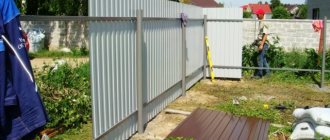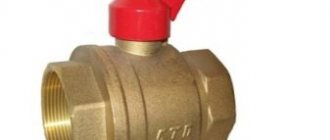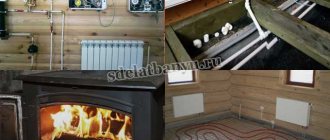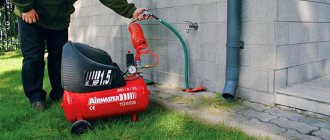The summer season is coming to an end. Many city dwellers are ready to come to their dacha in winter, but cannot solve the heating issue. We want to introduce you to the most common methods of heating a country house during the cold season.
We do not live in those latitudes where in winter the sun “distributes” heat for free. We have to pay for it: either with money or with our own labor. How can we heat our home?
The cheapest way is to use firewood, but we definitely need to put a lot of work into it. A simpler, but more expensive option is gas. The simplest and most expensive heating option is electricity. Which method is best for a country house?
Heaters
Depending on the operating principle and heat source, heaters are divided into oil, infrared, gas, etc.
Oil heater
What is an oil heater? This is the reservoir in which the heating element is located. Oil is also poured in there. Oil was not chosen as a coolant by chance: it takes a long time to heat up, but then, after maximum heating, it is able to maintain a high temperature for a long time.
This device has other advantages:
- relatively low price;
- mobility (unlike a battery, the heater can be moved to any place in the room or country house);
- there are no foreign odors or noise during its operation;
- When heating, it does not dry out the air in the room.
The disadvantages include the following:
- the oil heats up very slowly, so you will have to wait a long time for the air in the room to warm up. Oil heaters equipped with a fan do not have this drawback, although they are more expensive;
- Due to the massive body and the oil poured into the tank, these devices are quite heavy. If you have a two-story cottage, then when moving the device from one floor to another this can turn into a big problem;
- Due to the high heating temperature of the housing, there is a risk of burns. This is especially important in families with children;
- considerable cost of energy consumption during prolonged heating of the heater.
Infrared heater
An infrared heater has a completely different operating principle. The temperature rise there occurs due to the action of infrared rays (hence the name). They act like the sun's rays: they pass freely through the air without heating it. When some “obstacle” (person, animal, furniture, etc.) is encountered along the way, infrared rays are absorbed by it, and at the same time the temperature of this object or living creature rises. Thus, infrared heaters do not warm the air, but us and all objects that are in their zone of action. And now we give this heat to the air, increasing its temperature.
Infrared heaters can be installed on any surface: floor, wall or ceiling. They have tip-over protection, which immediately turns off the device after a fall. They also have other advantages:
- these devices do not waste time on prolonged warming up, like oil devices, but begin to give off heat immediately after switching on;
- they operate silently, do not create odor and do not burn oxygen in the room;
- Many models have sensors that prevent the device from overheating and maintain the temperature at the level desired by the owner.
Infrared heaters are not without their disadvantages:
- quite high price compared to oil heaters;
- limited distance between the device and an object/person, beyond which the effect of the device is no longer felt;
- If you stay in the area of infrared rays for a long time, your health may deteriorate: headache, dry skin and eyes.
Convectors: electric and gas
A slightly different type of heating device, which is often used to heat country houses during the cold season, are convectors. The principle of their operation is based on the property of cold air to sink down, displacing warm air from there. The latter rises up, cools there and falls down again. This is how natural air circulation occurs - convection. She gave the device its name – convector.
An electric convector consists of a housing, in the upper and lower parts of which there are air intake openings. There is a heating element located inside the housing. Cold air enters the housing from below and flows around the heating element. At this time, its temperature rises, and a hot air flow comes out of the case through the upper holes, which immediately rises up to the ceiling. There it gives off its heat to the surrounding space, cools and sinks down again. This heats up the room.
Advantages of convectors:
- warms up the air in the room very quickly;
- unlike heaters, the body of convectors hardly heats up, so it is impossible to get burned on it;
- fairly low noise level;
- The temperature sensor helps control the heat level in the room and turns off the device when the desired temperature is reached. Thanks to this, energy savings occur.
There is nothing ideal in the world, so convectors also have disadvantages:
- while the convector is operating, the humidity level decreases, the air becomes very dry;
- high electricity consumption;
- Without a working convector, the air cools very quickly, so the device must be turned on constantly.
Work organization
To install a heat pump, you need to make a circuit. If your house is on rocky soil, then one or more wells are drilled into it. Their total length is calculated based on the fact that for every meter of depression in the ground there is about 50 W of energy. If you plan to install a 10 kW heat pump, then you will need wells with a total depth of about 200 m.
If there is a plot of about 600 m2 near your house, then you can make an earthen contour. In order to make heating without gas and firewood, it is necessary to install special pipelines at the depth of soil freezing. To obtain 10 kW, the circuit needs to be about 500 m long.
The most preferable option is to use the nearest body of water. It must be flowable and large enough in size. It is necessary to install a water circuit with a total length of 333 m. This length is sufficient to produce 10 kW.
Air circuits are used less often. This is due to the fact that the minimum temperature at which such a pump can operate is -20 o C.
The principle of its operation is the same as that of any refrigeration machine. It consumes electricity and converts it into thermal energy. The pump removes heat from the refrigerated products, and the condenser transfers it to the room. That is, heat is taken from the bowels of the earth.
Various types of stoves
Not many people can afford to build a large stationary stove in their dacha. The majority of summer residents prefer more compact options.
Potbelly stove
Known since the end of the 19th century, the stove has again begun to be in quite high demand in recent decades. Only this time the summer residents became interested in her. According to many of them, for the rare heating of a small country house, nothing better can be found.
The modern potbelly stove differs from its ancestors mainly in appearance. Its structure has remained virtually unchanged. It consists of a firebox (the size may vary), a vent and a chimney. Some models have a flat surface on top on which you can heat the kettle or cook some simple food. The material can be steel (cheaper options) and cast iron.
The advantages of this heating source:
- compactness, which is important for small country houses;
- quick heating of the room - for summer residents who rarely visit during the cold season of the year, this is one of the most important criteria when choosing a heating device;
- relatively low price;
- ease of operation;
- the ability to use not only firewood as fuel, but also wood chips, wood waste, branches, etc.
The potbelly stove also has disadvantages:
- as much as you heat, you warm up as much: the body of the potbelly stove heats up quickly, and cools down just as quickly;
- some models have a small firebox, so the size of the logs should not exceed 20 cm;
- it cannot be left unattended, and the reason is not only that you need to constantly add firewood, but also safety: a hot body can cause a fire;
- the stove gets very hot, so it needs to be located at a considerable distance from walls and any flammable objects, which is not very convenient in small rooms; for safe operation, the potbelly stove must be installed on a foundation (legs) or thermally insulated with flame and analogues from the nearest walls and floor;
- For combustion, the stove uses oxygen from the room, “taking” it from people. For this reason, in order to avoid oxygen starvation, ventilation is indispensable;
- Frequent chimney cleaning will also not be to the liking of many summer residents.
Stove Buleryan
At the end of the last century, a furnace was invented, which is still considered the best in terms of efficiency and productivity. It combines the operating principles of a potbelly stove and a convector. Like a potbelly stove, the Buleryan stove has a metal body, the base of which is a firebox for wood. Metal pipes are soldered into the structure. Cold air enters the bottom of each pipe. Circling around the combustion chamber, the cold air heats up and comes out of the top of the pipes already hot (the operating principle of a convector is used). Thanks to it, the room is heated.
Positive aspects of the Buleryan stove:
- the room warms up in a short period of time;
- low fuel consumption: one load of firewood is enough for 12 hours, because the wood in the stove does not burn, but smolderes slowly (it is known that smoldering wood provides more heat than actively burning wood);
- the stove does not heat up, so a separate foundation for it is not needed.
Disadvantages of the Buleryan stove:
- You need to use only completely dried firewood for the stove, otherwise the heat transfer of the fuel will be much lower;
- the oven becomes very clogged, so it has to be cleaned frequently; The reason for the appearance of a large amount of soot on the walls of pipes can also be wet firewood;
- To maintain a constant temperature in the room, you need to frequently adjust the position of the damper - this is unlikely to happen the first time. It takes time to learn how to operate the Buleryan stove;
- due to incomplete combustion of wood, smoke is released into the room; to avoid this and improve draft, the chimney should rise 3-5 m above the stove.
Stove-fireplace
A fireplace stove can be an excellent option for heating a country house in winter. This equipment combines the functions of a fireplace and stove. From the first it has a firebox, through which you can admire the bright burning flame. From the stove - heat emanating from the walls and warming the entire room quite evenly.
Fireplace stoves can be either stationary, made of brick and placed on a foundation, or more modern, made of cast iron or steel. They do not require a special foundation - a platform made of fireproof material is enough, they are easy to install and easier to dismantle in case of moving. Many models also have a hob where you can cook.
In addition to those listed, fireplace stoves have other advantages:
- rapid heating of the room;
- ease of installation of equipment when it comes to metal structures;
- most people receive aesthetic pleasure from the sight of burning wood and its smell;
- many modern models serve as interior decoration.
The disadvantages include the following:
- many models have a shallow firebox, which requires the preparation of small firewood;
- laying firewood is required several times a day: with intense combustion, the fuel lasts only a few hours;
- heating of the room occurs unevenly: warm air rushes upward, and at the same time it can be quite cold below.
Solar panels
Using solar energy for heating is the most inexpensive and accessible way. The main task is to convert sunlight into heat with minimal losses.
System design
The main element of such a system is the solar collector. This is a device consisting of tubes that lead to a coolant reservoir. There are vacuum, air and flat collectors. In addition to them, the composition includes the following units:
- heat exchanger;
- storage tank;
- pipeline;
- front camera.
A storage tank is a container with heated coolant. From the top of the container, liquid is supplied to the heating devices. After passing through the entire heating circuit, the cooled coolant again enters the tank.
The anterior chamber serves to prevent air retention in the heating pipeline. It is a tank that is located at the highest point of the system. Collectors must be installed at an angle of 35–40°. This slope will ensure maximum efficiency. To minimize heat losses, all pipelines leading from the collector to the heat exchanger must be insulated.
Advantages and disadvantages
It is worth noting the main advantages of a solar battery:
- high efficiency;
- long service life - more than 25 years;
- ease of maintenance;
- independence from low air temperatures.
But it is still better to use batteries as an additional source of heat for private homes. In winter, the sun's energy will not be enough to accumulate the required amount of heat. During periods of increased cloudiness, your home may also remain cold. New technologies make it possible to combine several types of heating into one complex, and solar panels can be combined with a geothermal installation or infrared radiation.
Disadvantages also include very high prices for solar collectors and equipment. To heat a 100 m² house, installing solar panels will cost approximately 900,000 rubles.
Gas equipment: heaters and convector
In addition to firewood and electricity, there is another source of thermal energy that many summer residents successfully use - gas. If gas is not supplied to your dacha, you can use liquefied gas (it is supplied in cylinders): currently, many heating devices can operate on any of these types of fuel. Equipment that runs on gas in a country house is used:
- infrared gas heater,
- gas convectors,
- catalytic gas heater.
The operating principle of the first two devices is no different from their counterparts powered by electricity. But the action of a catalytic heater is based on the interaction of burning gas with a special catalyst plate. During combustion, the gas, thanks to the catalyst, is oxidized. The oxidation reaction is accompanied by the release of a large amount of heat, which warms the room. Gas consumption is quite small, because the oxidation reaction depends simply on combustion, and not on its power.
Advantages of gas equipment:
- fairly low gas prices;
- ease of installation, mobility;
- rapid heating of the room;
- reliability.
Not without its drawbacks:
- when using gas cylinders there is always a risk of gas leakage;
- at low temperatures there may be a problem with turning on the gas heater;
- infrared gas heaters are quite expensive, and if they break down, repairing them will also cost you a pretty penny;
- When gas is burned in convectors, combustion products are formed, for the removal of which a chimney is required;
- Catalytic heaters have practically no combustion products, but they have another disadvantage - a limited service life. When using low-quality gas, it is greatly reduced.
Solar heating
It is possible to convert solar energy into thermal energy only if the sun shines frequently and for a long time over the roof of your house. Unfortunately, 80% of Russian territories have nothing to do with this. However, even in warm climates you cannot rely solely on solar heating; a backup source is definitely needed.
Principle of operation
Light-absorbing batteries are installed in place “under the sun,” which process solar energy directly into thermal energy and then transfer it to the coolant. There are two types of solar collectors - vacuum and flat. Vacuum ones are considered the most efficient and economical. Using solar energy is an achievement of science.
So what is the best way to heat a dacha in winter?
It is difficult to answer this question unequivocally. Heaters that are powered from the electrical network are the simplest and most convenient, but at the same time the most expensive option. Solid fuel stoves (mostly firewood or other wood-based fuels) are the cheapest, but at the same time the most labor-intensive way to heat a dacha in the cold season. Somewhere in the middle between them there is heating equipment that runs on gas.
According to experienced summer residents, it is best to use a combination of several methods to heat a house. For example, immediately after arrival you need to quickly heat the house. Here a stove will come to the rescue (both a potbelly stove and a Buleryan stove will do). When the stove stops producing heat (for example, at night), heaters come into play. Infrared heaters that have a function of maintaining a constant temperature are best suited for this purpose: the temperature in the room has dropped - the sensor has triggered and turned on the heater.
There are a lot of options for heating a country house in the cold season. How do you heat the room?
Liquefied gas
Liquefied gas is precisely the heating option that should be considered in exceptional cases. Liquefied gas itself is quite expensive, and in addition there is a need to install a massive gas tank, which, when buried in the ground, will take up a considerable usable area of the site.
Such a “gas storage” when performing turnkey work will cost about 200 thousand rubles with a gas volume of 5,000 liters and about 1 million rubles with a gas volume of 20,000 liters. In this case, it is much more profitable to use a solid fuel boiler with pellets.
The cheapest option is a solid fuel boiler without automatic fuel supply. The unit itself will cost 30-35 thousand rubles, however, the stove will have to be heated manually.
Heating with solid fuel
The closest alternative to gas in domestic realities can be called solid fuel: firewood, peat, coal or briquettes. In terms of cost, solid fuel heating boilers are somewhat cheaper than gas boilers; they do not require such strict control of safety systems, but that is where their advantages end.
Basically, wood-burning boilers or fireplaces are seriously considered as the main method of heating a home in cases where, over the next few decades, the slightly higher cost of fuel does not compare with the cost of connecting to the gas supply system. Such heating equipment is not without its drawbacks: the boiler needs to be constantly replenished with fuel, combustion produces a significant amount of soot and ash, and there are difficulties with adjusting power.
We are spoiled by comfort, you can’t argue with that. But there are also positive changes in the development of solid fuel heating equipment designed to improve ease of use. The simplest solution for civil residential buildings can be called long-burning boilers: they are loaded at intervals of one to several days, and the combustion intensity is approximately the same both at the beginning and at the end of the cycle. Modern solid fuel boilers, equipped with automatic devices, are able to maintain the temperature of the coolant with an accuracy of 2-3 ºС by regulating the air supply necessary to maintain combustion.
The most technologically advanced in this regard are heating units that are specifically designed for the use of a special type of fuel - briquettes and pellets. In the latter case, it is possible to install a bunker, as well as automatic fuel supply and ash removal mechanisms. If such equipment is available, the home owner will have to visit the boiler room quite rarely, from 3-4 days to several weeks, it all depends on the storage capacity. Problems with the formation of soot and tar are also eliminated: the prepared fuel has extremely low humidity and does not cause condensation of moisture from the exhaust gases.
Adviсe
The choice of suitable fuel is influenced by the total area and level of energy efficiency of the house, the average temperature and length of the heating season, access to energy resources and tariffs, as well as restrictions on the allocated electricity capacity for private needs.
“If none of the proposed options has a clear superiority over the others, then you can resort to combining them. Meanwhile, under equal conditions, the optimal solution would be to use main gas, despite the impressive investments at the initial stage. If it is not possible to connect to the gas pipeline, then the most rational option for larger houses would be to install a gas holder, while for smaller areas gas cylinders are sufficient. Electricity is a convenient option, but if there are no incentives to pay for it, then in the end it will be the most expensive heating method, despite the minimal cost of connection,” advised Viktor Timokhin.
The bar chart compares the relative cost of the initial investment and subsequent maintenance of popular heating sources. The data applies to an insulated country house with an area of 150 square meters. m in the Moscow region with a heating season from October to May. Compiled and sent by Viktor Timokhin
Why electricity
Electric heating differs from classic water-stove and gas systems by being more economical and practical. We will leave the first aspect for discussion below, and describe the operational advantages here:
Electric heating is not only silent, but also environmentally friendly. It is transported safer than gas and does not emit harmful substances at all, both into the atmosphere and indoors. In the absence of waste, the need for exhaust chimneys and traction structures disappears. Heating using coal or wood is not at all comparable to electric systems. Heating with electricity does not require large one-time costs. You can make a comparison using gas as an example: to connect a house you must purchase equipment for each room, install communications, a boiler, and connect it to a common pipeline. Moreover, all this must be done together, since it is impossible to postpone connecting any part of the house to the system. And the electrical method allows you to organize sequential installation: first, the most important parts of the house are connected, and then, as funds accumulate, peripheral parts are connected. Thanks to the possibility of using a multi-tariff meter in a private house or apartment, as well as the constant development of technology in this area, electric heating is already the most economical among analogues
You should not focus on the high price of the equipment - it quickly pays for itself due to low energy consumption. Almost every method of organizing electric heating allows you to install it yourself, without many additional tools.
Of course, the use of electrical systems for heating cannot be called ideal. The work of high-quality heating of each home requires taking into account many features. In some regions, the cost of electricity can be so high that gas cannot be avoided. In old apartment buildings, it is difficult to switch to electric heating for two reasons: it is very difficult to disconnect from the central highway, and the electrical network will have to be reconnected, taking into account powerful equipment.
Despite this, the overall picture tips the scales towards electricity. For premises where there is no gas or where there is no possibility of supplying it, it is a real salvation.
Modern economical technologies
This technology includes a heat pump.
With the help of earthly resources, it is capable of producing at least 4 times more energy than it consumes itself. If you need a boiler for your home with a power of 20 kW, then a heat pump with a power of only 5 kW will be suitable for heating. The heat pump runs on electricity. The pump also costs 3-4 times more than a first-class gas boiler with high efficiency. Solar collectors can be used for heating. There is no energy consumption required at all. When properly installed, solar collectors can heat heated floors and provide you with the necessary amount of hot water. But again, it all comes down to finances.
Our future lies in these technologies. The moment will come when both a heat pump and a solar collector will become available to everyone.
As a result, we get that using a warm floor + temperature control + a heat pump (or collector) we can get truly the most economical home heating.
If you are looking far ahead and are confident that you can afford such expenses, then you definitely will not regret having all this installed at home.
Electric boilers
Electric boilers have the highest efficiency - up to 98%. Moreover, it does not depend on the type of boiler. Heating element, electrode and induction boilers differ only in the method of heating the coolant, and they have no losses from incomplete combustion of fuel - electricity is almost completely converted into heat. In principle, it would be correct to talk not about the heating system (there is no fuel and combustion chamber), but about the heating method.
In terms of equipment cost, simplicity of design, complete automation and ease of maintenance, electric boilers have no competitors. But their cost per kilowatt of thermal energy is the highest. Although there are loopholes here.











